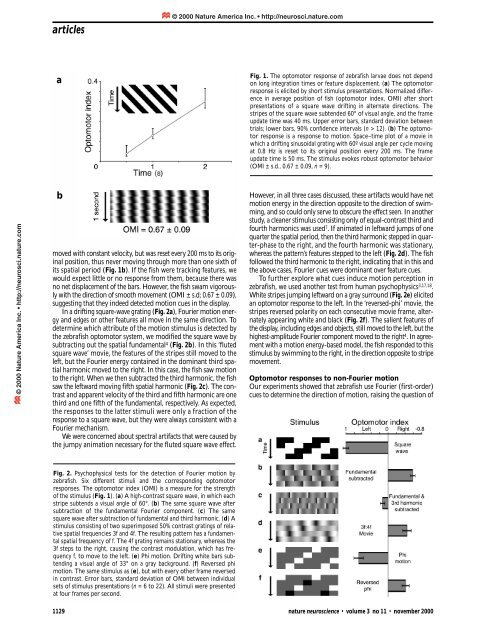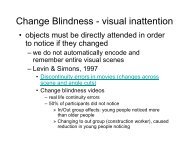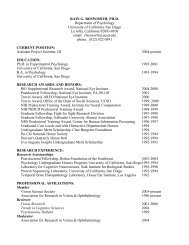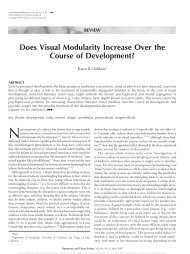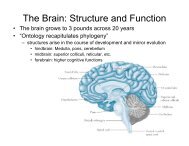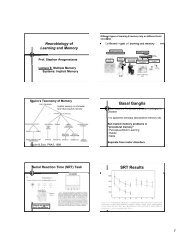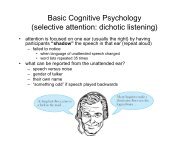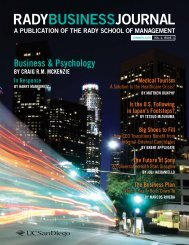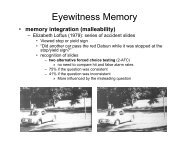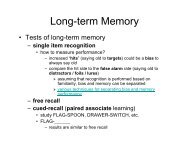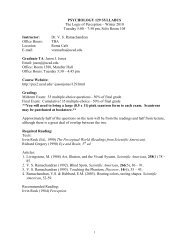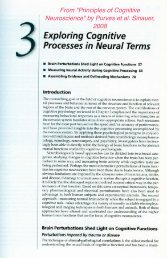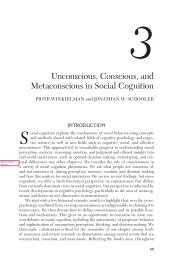Perception of Fourier and non- Fourier motion by ... - ResearchGate
Perception of Fourier and non- Fourier motion by ... - ResearchGate
Perception of Fourier and non- Fourier motion by ... - ResearchGate
Create successful ePaper yourself
Turn your PDF publications into a flip-book with our unique Google optimized e-Paper software.
© 2000 Nature America Inc. • http://neurosci.nature.com<br />
articles<br />
a<br />
b<br />
moved with constant velocity, but was reset every 200 ms to its original<br />
position, thus never moving through more than one sixth <strong>of</strong><br />
its spatial period (Fig. 1b). If the fish were tracking features, we<br />
would expect little or no response from them, because there was<br />
no net displacement <strong>of</strong> the bars. However, the fish swam vigorously<br />
with the direction <strong>of</strong> smooth movement (OMI ± s.d; 0.67 ± 0.09),<br />
suggesting that they indeed detected <strong>motion</strong> cues in the display.<br />
In a drifting square-wave grating (Fig. 2a), <strong>Fourier</strong> <strong>motion</strong> energy<br />
<strong>and</strong> edges or other features all move in the same direction. To<br />
determine which attribute <strong>of</strong> the <strong>motion</strong> stimulus is detected <strong>by</strong><br />
the zebrafish optomotor system, we modified the square wave <strong>by</strong><br />
subtracting out the spatial fundamental 4 (Fig. 2b). In this ‘fluted<br />
square wave’ movie, the features <strong>of</strong> the stripes still moved to the<br />
left, but the <strong>Fourier</strong> energy contained in the dominant third spatial<br />
harmonic moved to the right. In this case, the fish saw <strong>motion</strong><br />
to the right. When we then subtracted the third harmonic, the fish<br />
saw the leftward moving fifth spatial harmonic (Fig. 2c). The contrast<br />
<strong>and</strong> apparent velocity <strong>of</strong> the third <strong>and</strong> fifth harmonic are one<br />
third <strong>and</strong> one fifth <strong>of</strong> the fundamental, respectively. As expected,<br />
the responses to the latter stimuli were only a fraction <strong>of</strong> the<br />
response to a square wave, but they were always consistent with a<br />
<strong>Fourier</strong> mechanism.<br />
We were concerned about spectral artifacts that were caused <strong>by</strong><br />
the jumpy animation necessary for the fluted square wave effect.<br />
Fig. 2. Psychophysical tests for the detection <strong>of</strong> <strong>Fourier</strong> <strong>motion</strong> <strong>by</strong><br />
zebrafish. Six different stimuli <strong>and</strong> the corresponding optomotor<br />
responses. The optomotor index (OMI) is a measure for the strength<br />
<strong>of</strong> the stimulus (Fig. 1). (a) A high-contrast square wave, in which each<br />
stripe subtends a visual angle <strong>of</strong> 60°. (b) The same square wave after<br />
subtraction <strong>of</strong> the fundamental <strong>Fourier</strong> component. (c) The same<br />
square wave after subtraction <strong>of</strong> fundamental <strong>and</strong> third harmonic. (d) A<br />
stimulus consisting <strong>of</strong> two superimposed 50% contrast gratings <strong>of</strong> relative<br />
spatial frequencies 3f <strong>and</strong> 4f. The resulting pattern has a fundamental<br />
spatial frequency <strong>of</strong> f. The 4f grating remains stationary, whereas the<br />
3f steps to the right, causing the contrast modulation, which has frequency<br />
f, to move to the left. (e) Phi <strong>motion</strong>. Drifting white bars subtending<br />
a visual angle <strong>of</strong> 33° on a gray background. (f) Reversed phi<br />
<strong>motion</strong>. The same stimulus as (e), but with every other frame reversed<br />
in contrast. Error bars, st<strong>and</strong>ard deviation <strong>of</strong> OMI between individual<br />
sets <strong>of</strong> stimulus presentations (n = 6 to 22). All stimuli were presented<br />
at four frames per second.<br />
© 2000 Nature America Inc. • http://neurosci.nature.com<br />
Fig. 1. The optomotor response <strong>of</strong> zebrafish larvae does not depend<br />
on long integration times or feature displacement. (a) The optomotor<br />
response is elicited <strong>by</strong> short stimulus presentations. Normalized difference<br />
in average position <strong>of</strong> fish (optomotor index, OMI) after short<br />
presentations <strong>of</strong> a square wave drifting in alternate directions. The<br />
stripes <strong>of</strong> the square wave subtended 60° <strong>of</strong> visual angle, <strong>and</strong> the frame<br />
update time was 40 ms. Upper error bars, st<strong>and</strong>ard deviation between<br />
trials; lower bars, 90% confidence intervals (n > 12). (b) The optomotor<br />
response is a response to <strong>motion</strong>. Space–time plot <strong>of</strong> a movie in<br />
which a drifting sinusoidal grating with 60º visual angle per cycle moving<br />
at 0.8 Hz is reset to its original position every 200 ms. The frame<br />
update time is 50 ms. The stimulus evokes robust optomotor behavior<br />
(OMI ± s.d., 0.67 ± 0.09, n = 9).<br />
However, in all three cases discussed, these artifacts would have net<br />
<strong>motion</strong> energy in the direction opposite to the direction <strong>of</strong> swimming,<br />
<strong>and</strong> so could only serve to obscure the effect seen. In another<br />
study, a cleaner stimulus consisting only <strong>of</strong> equal-contrast third <strong>and</strong><br />
fourth harmonics was used 7 . If animated in leftward jumps <strong>of</strong> one<br />
quarter the spatial period, then the third harmonic stepped in quarter-phase<br />
to the right, <strong>and</strong> the fourth harmonic was stationary,<br />
whereas the pattern’s features stepped to the left (Fig. 2d). The fish<br />
followed the third harmonic to the right, indicating that in this <strong>and</strong><br />
the above cases, <strong>Fourier</strong> cues were dominant over feature cues.<br />
To further explore what cues induce <strong>motion</strong> perception in<br />
zebrafish, we used another test from human psychophysics 3,17,18 .<br />
White stripes jumping leftward on a gray surround (Fig. 2e) elicited<br />
an optomotor response to the left. In the ‘reversed-phi’ movie, the<br />
stripes reversed polarity on each consecutive movie frame, alternately<br />
appearing white <strong>and</strong> black (Fig. 2f). The salient features <strong>of</strong><br />
the display, including edges <strong>and</strong> objects, still moved to the left, but the<br />
highest-amplitude <strong>Fourier</strong> component moved to the right 4 . In agreement<br />
with a <strong>motion</strong> energy-based model, the fish responded to this<br />
stimulus <strong>by</strong> swimming to the right, in the direction opposite to stripe<br />
movement.<br />
Optomotor responses to <strong>non</strong>-<strong>Fourier</strong> <strong>motion</strong><br />
Our experiments showed that zebrafish use <strong>Fourier</strong> (first-order)<br />
cues to determine the direction <strong>of</strong> <strong>motion</strong>, raising the question <strong>of</strong><br />
1129 nature neuroscience • volume 3 no 11 • november 2000


